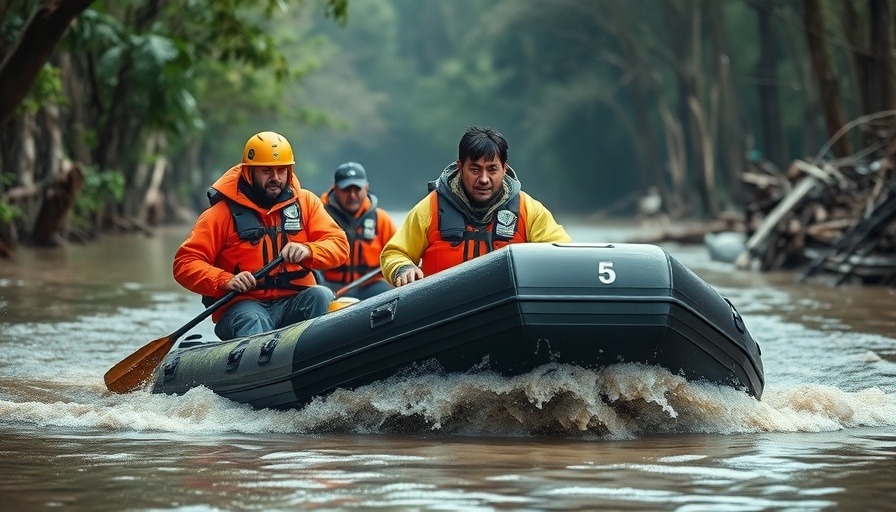
Understanding the Flood Crisis in Texas: A Meteorological Perspective
The recent flash floods in Texas, which resulted in the tragic death of at least 27 individuals, have sparked intense debate regarding weather forecasting and emergency preparedness. On July 4, 2025, a storm of unprecedented severity swept through central Texas, accusing the National Weather Service (NWS) of failing to appropriately predict the situation. However, a closer look reveals that according to meteorologists, the NWS had indeed done its job by issuing warnings based on available data.
The Role of the National Weather Service in Crisis Situations
The NWS has faced scrutiny for its forecasts leading up to the catastrophic events. Critics have pointed fingers at budget cuts affecting the agency, suggesting these reductions contributed to inadequate warnings. However, experts argue that while predictions can be difficult to make with extreme weather events, the NWS's forecasts were both timely and precise in alerting communities to potential risks. Meteorologists indicate that they were aware of an impending storm as early as the weekend preceding the flood when Tropical Storm Barry made landfall in Mexico.
Local Officials and the Perception of Forecasting Failures
Criticism was voiced by local officials such as Kerr County judge Rob Kelly, who claimed the authorities were ill-prepared for the catastrophe. The suddenness of the flood, which saw the Guadalupe River jump over 20 feet in just hours, caught many off guard. Officials noted that despite being familiar with floods, this specific event differed dramatically from previous experiences. In the fast-paced world of weather forecasting, the challenge is often to predict not just the occurrence of rain but its intensity—the proverbial needle in a haystack.
The Science Behind Flash Flood Predictions
While meteorological models had predicted flooding, dynamism in weather patterns can complicate accuracy. Chris Vagasky, a certified digital meteorologist, emphasizes the difficulty in forecasting precisely how much rain any given storm might produce. As evidenced by this tragic scenario, vast amounts of rainfall can quickly accumulate, leading to flash flooding. An intensive analysis of meteorological data is essential to refine models and create better predictions, echoing the need for continuous support and funding for institutions like the NWS.
Lessons Learned and Future Considerations
In light of this event, there arises a significant question: How can governmental agencies boost preparedness for future incidents? As the climate crisis continues to unveil more extreme weather patterns, enhancing predictive capabilities is paramount. This includes investing in improved modeling technologies and ensuring that the agency is adequately funded to perform its essential tasks.
The Importance of Effective Communication in Emergency Management
Communicating risk is just as crucial as predicting it. Emergency departments, meteorologists, and local governments must collaborate to disseminate information clearly and effectively. Following events such as the Texas floods, it is essential for organizations to evaluate their communication strategies and ensure that the public is not only warned about potential threats but is also educated on what actions to take. This ultimately empowers communities to respond effectively when crises arise.
Social Media’s Impact on Public Perception of Weather Services
In the age of information, social media has become a double-edged sword in the context of weather emergencies. Misinformation can spread rapidly, with individuals sharing anecdotes and complaints about services like the NWS. This not only undermines public trust but can affect funding and resources allocated to critical agencies. Engaging the public through proper channels, like educational outreach and community engagement, can combat this challenge.
Looking Ahead: The Future of Weather Preparedness
As we reflect on the devastating floods in Texas, the future must be approached with foresight in mind. It aligns with a broader discussion on how society can leverage technology for better predictions while maintaining support for vital meteorological services, ensuring that human life is protected effectively. Ultimately, as meteorological technology evolves, so too should our strategies in disaster preparedness.
Take Action: Support Funding for Meteorological Services
The recent flood crisis highlights the critical role that accurate weather forecasting plays in saving lives. To ensure that we continue to receive timely and effective warnings in the future, it is imperative to advocate for stable funding for institutions like the NWS. Engaging with community representatives and fostering discussions about climate change and preparedness can pave the way for more resilient communities.
 Add Row
Add Row  Add
Add 




Write A Comment